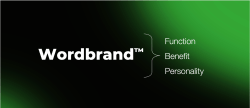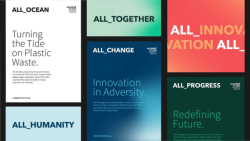
What’s in a name? More than many businesses realise. Every story starts with one, and in frontier sectors like fintech, technology, and ESG, where companies rise and fall with unprecedented speed, the right name can help make the difference between fleeting recognition and lasting impact.
In this month’s The Brief, we explore the challenges of naming in these fast-moving categories, through the lens of our proven Wordbrand™ methodology. We’ve also set up a short survey to help you test your own approach to naming. Take a minute, because in naming, the smallest choices can carry the greatest consequences.

Why Naming Strategy Matters Even More in Frontier Sectors
Naming a business or product can appear deceptively simple. A brainstorm or two, a quick online check, and a few syllables emerge, blinking into the light of day. They are expected to grow fast, stand tall, and carry an identity for decades.
But the reality is rarely so straightforward. Naming projects often begin with great excitement and creative ambition, only to end with an unsatisfying sense of compromise. With naming, everyone becomes a parent: fiercely protective, emotionally invested, and convinced their creation is the most beautiful. This passion can be liberating, but also politically tense, as personal attachment overtakes objectivity.
That’s why naming – often seen as a purely right-brained creative discipline – also demands structured analysis to succeed. In today’s hyper-evolving, AI-disrupted, attention-deficient landscape, a name is rarely ‘just a name.’ It is a brand’s formative identity – a compact vessel of trust, distinctiveness, and purpose. And it has never been harder to get right.
In fast-moving, high-scrutiny frontier industries such as fintech, new technology, and ESG, the challenge is amplified. These are pressure-cooker sectors: expanding rapidly, fiercely competitive, and under intense oversight from regulators, investors, and communities.
Unlike consumer goods giants with vast marketing budgets and endless real estate to nurture recognition, frontier players often depend on the name itself to carry disproportionate weight: introducing, explaining, and reassuring all at once. A weak name can stunt growth, undermine credibility, or leave a brand stuck in generic sameness, while a strong one can become a rallying cry, a differentiator, and the foundation on which a whole identity matures.
At Bonsey Design, we’ve seen how names can shape growth trajectories across frontier sectors. From naming Southeast Asian telco pioneers Maxis and M1, to digital innovators such as Bank Saqu and by.U in Indonesia, the strategic choices behind a name can help determine whether a venture earns trust, expands its audience, and scales across markets.

Per Loov: Unsplash
The Growing Challenge of Naming in Frontier Sectors
At the heart of successful naming, the challenge is creating a name that can mean the same thing to potentially millions of people from different countries and walks of life. But with each new company registration, the task becomes more difficult, due to:
- Convergence and sameness – Too many players sound alike, especially in fintech, where the desire to bolt on easy-win prefixes like “pay,” “fin,” and “neo” can outweigh originality
- Scarcity of availability – After decades of exponential brand creation, the pool of short, distinctive names that can be registered cleanly has shrunk dramatically. More entrants mean fewer distinctive options, leading to more trademark conflicts.
- Cross-border complexity – Ventures rarely stay confined to one country, so names must work across languages, cultures, and trademark systems. What is viable in Singapore might already be locked in Indonesia, India, or the EU
- High-stakes scrutiny – Regulators, investors, and the public all read meaning into a name, so it must withstand reputational pressure and not invite accusations of any kind of ‘washing’.
- Speed of cycles – New categories emerge and mature in months, not years, so names must feel relevant today while remaining future-proof.
In such a crowded, high-pressure environment, clarity becomes the ultimate differentiator.
Not sure how your current naming strategy stacks up?
Take our simple survey to find out…
Wordbrand™ – Finding Naming Clarity Amid Confusion
Across sectors, consumers and investors face a bewildering array of brands. At its simplest, the task of a name is to cut through – to make it easier for people to understand what your business is, why it matters, and why they should trust it. That’s why naming is such a powerful lever. A well-chosen name can:
- Identify an organisation, product, or family of services
- Function as defensible intellectual property
- Build value through recognition and recall
- Express an idea, benefit, or distinctive quality in a way no other brand element can
Today, names must work harder than ever. They need to carry meaning across markets, bring focus in crowded categories, hold their own against global players, and withstand fast-changing trademark environments. They must also align founders, boards, and teams around a shared identity.
At the same time, names cannot do everything. They are the tip of the spear: the first word people hear, the first clue to what a brand stands for, but not the whole brand itself. Strong names may seem ill-fitting at first, only revealing their power as the brand and its audiences grow into them. That’s why naming demands a balance of art, science, and context.
At Bonsey Design, we developed Wordbrand™ to strike that balance – combining creative spark, rigorous testing, and patience to ensure names aren’t just created, but built to endure.

Breaking Down WordBrand™
At its core, Wordbrand™ approaches every name through three lenses:
- Function: the plain truth of what the brand does
- Benefit: the way it improves the world
- Personality: the distinctive spirit in which it delivers
These lenses keep creativity tethered to strategy, while a range of creative drills – from analogies and image associations to role-playing and synonym explosions – deliberately break clichés and push language into unexpected places. The result is not just a list of names, but a richer vocabulary for brands to draw on.
Wordbrand™ is not only about invention. It is equally about evaluation: asking whether an existing name has the equity and stretch to grow with the business, or if reinvention is truly required. In some cases, the smarter choice may be to build on an existing foundation rather than start over.
Wordbrand™ In Action
Talking Trust in Fintech – Southeast Asia’s fintech boom has created hundreds of new players across payments, lending, and digital banking. But as regulators tighten oversight and weaker firms exit, the market is likely to consolidate around a handful of names that carry increasing weight in brand equity and public trust.
In Singapore, where governance and credibility are paramount, digital first-mover Trust Bank chose a bold naming strategy: putting the most fundamental consumer expectation front and centre. In a market where digital banks are still loss-making and customer loyalty can be transient, such simplicity is powerful, but it also invites scrutiny, as the brand must continually prove it deserves the name.
In Indonesia, the challenge was more nuanced. As a late entrant into a crowded market, Astra Financial and WeLab needed a name that connected functionally with SMEs and solopreneurs while validating their role in building the new economy. Emerging from the Wordbrand™ methodology, Bank Saqu draws on “saku” (pocket) to highlight personalised money management, while its closeness to bangsa ku (“my nation”) frames entrepreneurship as a driver of national progress. The result balances everyday relevance with cultural ambition.
Technology: New Rules, New Names – In dynamic technology categories, names must be flexible enough to evolve with changing business models, yet distinctive enough to stand out in a sea of innovation. Sometimes the challenge is not inventing a new name, but deciding whether an existing one can adapt.
For Telkomsel, launching a digital telco aimed squarely at Gen Z required clear separation from the parent. The result was by.U – a brand that broke convention through flexibility and personalisation. The name suggested empowerment (“by you”) while echoing Bayu, a common male name meaning “wind,” adding warmth and cultural depth. Fresh, individualised, and socially native, by.U quickly found its place among digital-savvy users.
Not every case calls for invention. When Temasek-backed Affinidi pivoted from digital identity platform to holistic identity solutions, Bonsey Design evaluated whether the existing name had the stretch to grow. We concluded that retaining it carried more equity than replacing it. The strategy shifted to layering new meaning into a familiar name, demonstrating how careful stewardship can be as powerful as bold reinvention.
ESG: Naming Under Scrutiny – Few sectors face more pressure to demonstrate credibility than ESG. Here, a name is not just a label, but a signal of commitment to regulators, investors, partners, and the public.
The Alliance to End Plastic Waste – already had a formal name that conveyed purpose and transparency, fitting its membership model and industry partners. But it also carried limits: long, institutional, and at risk of alienating NGOs, activists, and the wider public. Worse, it risked being perceived as protecting industry interests rather than driving real change.
The solution was not reinvention but adaptation. Bonsey Design created the short form ALL, versatile enough for boardrooms yet inclusive enough to engage broader stakeholders. Crucially, it reframed the brand as collective – standing for “all of us.” This subtle shift pushed back against negative perceptions and opened space for more inclusive conversations. It shows how naming strategy can extend beyond creation into architecting layers of meaning that broaden relevance without diluting credibility.
Getting Naming Right, From First to Last
A name is a brand’s first word. It may seem rudimentary at the start, but over time it becomes a marker of identity that others rely on.
In frontier sectors such as fintech, technology, and ESG, names must prove their worth quickly. They cannot be tentative. They must earn trust, stand out amid noise, and stretch to support evolving business models.
This is where a process like Wordbrand™ proves its value. By combining creativity with analysis, and balancing function, benefit, and personality, it ensures names are not just coined but designed to grow into enduring assets.
The strongest names don’t just make a first impression. They create the foundations for a lasting dialogue. Distinct, credible, and resilient, they are capable of carrying brands confidently from infancy to maturity in the world’s most demanding sectors.


